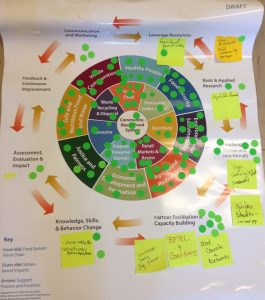by Liz Kirchner, Virginia SARE Outreach Coordinator and Healthy Food Access Project, Virginia Cooperative Extension Service, Northern District
 Home garden food production – even if that means a tomato in a bucket – is widely recognized to contribute to household nutrition and self-reliance. Garden produce strengthens ties between neighbors as those tomatoes are swapped, and maintains traditional foodways as gardening stories, seeds, and cooking skills are shared. However, not everybody realizes that SNAP benefits can be used to purchase seeds and seedlings, a caveat to the 1973 Farm Bill gauged to help people plant gardens. To raise awareness – and home gardens, too – Virginia Cooperative Extension’s Health Food Access program will host a series of seedling planting events with food pantry clients throughout the spring.
Home garden food production – even if that means a tomato in a bucket – is widely recognized to contribute to household nutrition and self-reliance. Garden produce strengthens ties between neighbors as those tomatoes are swapped, and maintains traditional foodways as gardening stories, seeds, and cooking skills are shared. However, not everybody realizes that SNAP benefits can be used to purchase seeds and seedlings, a caveat to the 1973 Farm Bill gauged to help people plant gardens. To raise awareness – and home gardens, too – Virginia Cooperative Extension’s Health Food Access program will host a series of seedling planting events with food pantry clients throughout the spring.
We will begin in May, after the frost-free date. The project goal is to send SNAP clients and other food pantry participants home with a planted seedling and a mapped list of nearby SNAP retailers who sell seedlings. Retailers identified using the ArcGIS, Google Maps, and the Buy Fresh Buy Local Guide include Walmart, some Food Lions, independent groceries, and the Staunton, Dayton, Waynesboro, and Harrisonburg Farmers’ Markets. (Continue reading)



